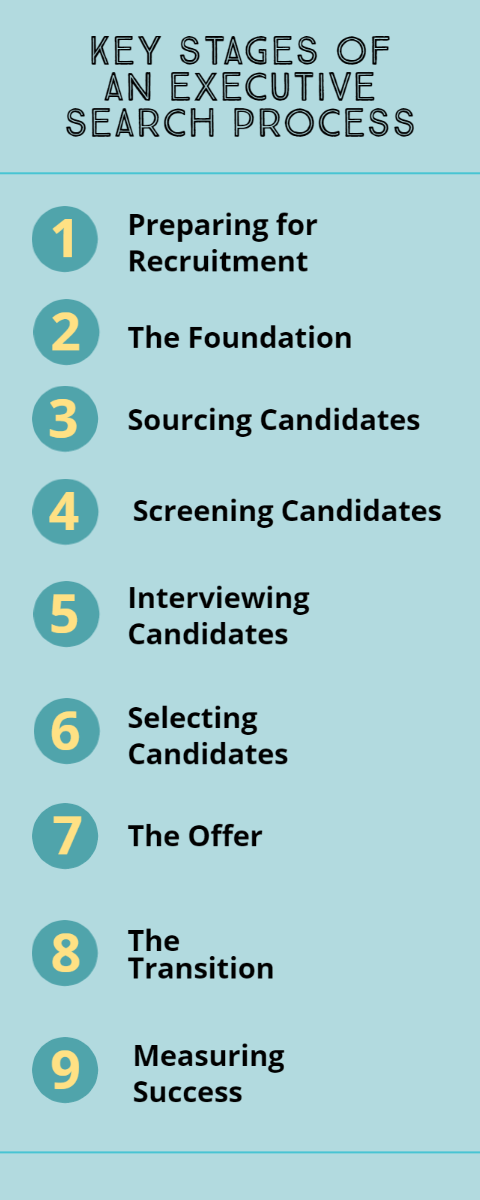Executive recruiting is a specialised type of talent acquisition that focuses on filling senior level management roles (typically referred to as c-suite level or leadership), or governance roles (executive and non-executive directors and chairs).
Senior level positions are characterised as business-critical in that they have a disproportionate impact on an organisation’s bottom line. There’s an urgency required in filling these roles, and criticality in terms of making the right hiring decisions.
For these reasons, companies often partner with an executive search firm to assist in the hiring process.
Regardless of which option you take, outsource or in-house recruitment, it is important to have some understanding of the executive recruitment process.
What Is Executive Recruitment?
Executive recruitment, also known as executive search, is the process of identifying, attracting, and hiring high-level professionals and leaders for top positions within an organisation. This specialised form of recruitment focuses on filling positions such as CEOs, CFOs, CTOs, and other senior executives.
The goal of executive recruitment is to find candidates who possess the necessary skills, experience, and leadership qualities to drive an organisation’s strategic goals and overall success.
What Is The Executive Recruitment Process?
In this section, we’ll outline the key stages of the executive recruitment process as represented in the following graphic.
Click on the graphic to download a pdf.
Preparing for Recruitment
Every role in your organisation serves a purpose, with specific accountabilities and capabilities required that collectively are the drivers of overall business performance.
Creating new roles or backfilling existing vacancies isn’t a task to take lightly or completed in an ad hoc manner with disregard for your overall people strategy.
We always recommend investing time in ensuring good Organisational Design. This is a strategic process that involves the creation of roles, processes and structures to ensure that an organisation’s goals can be realised.
Once you’ve determined the role purpose and where the role ‘sits’ in your organisational structure, it’s time to home in on the specific responsibilities and accountabilities of the role.
The Foundation
It’s important to invest time up-front to fully understand what is required in the ‘right’ candidate for a role, including the development of a candidate profile and candidate brief.
What you should consider:
- Finalise position description and candidate brief.
- Broadly decide on a remuneration package for the role.
- Determine who will be involved in the process, what they will be responsible for, and agree on a timeline.
- Craft a search and advertising strategy to attract the right candidates.
- Clarify criteria to evaluate the suitability of applicants (based on the candidate profile).
- Consider interview or bias training for staff involved in the selection and assessment stage.
You should also be thinking about whether you will be enlisting the services of a professional executive search consultancy or relying on internal capability. An executive search firm will provide valuable insights and direction for this stage of the process.
FAQ: Do I need an executive search firm?
Outsourcing your recruitment efforts has the obvious advantage of freeing up your time as well as leveraging the professional knowledge from experts in the field. The advice and guidance of a recruiter external to your business will also help you look at things slightly differently, particularly when it comes to assessing the suitability of applicants.
Read more about executive search firms in our latest blog.
Sourcing Candidates
This stage in the process is absolutely key to making the right hiring decisions and will likely take up a large amount of time.
It’s at this point that you execute your search and advertising strategy to uncover both passive and active candidates who meet the role requirements.
Check out our recent blog on how to attract passive candidates.
This is when you will really benefit from the services of an executive search firm, as you will have access to their broad and deep connections and networks, which will deliver a wider pool of qualified candidates.
If your company is not recruiting senior level roles frequently, your internal HR teams may not have up-to-date insights into candidate mobility at this level. Again, it’s the job of an executive search firm to keep abreast of talent markets and cultivate real-time talent pools.
You should also be considering internal candidates for a senior leadership role; it’s a sign of a company that prioritises employee growth and development. If you don’t have any internal talent “up to the task” then you should be asking some hard questions about what you are doing to support your high potentials.
Screening Candidates
Candidate screening happens early in the recruitment process. It’s an initial stage gate to assess whether an individual broadly meets the requirements for a role.
Beyond reviewing a candidate’s CV and online profile (for example LinkedIn), screening needs to include a conversation with the person. This will likely happen on the phone or remotely, and include a set of screening questions relevant to the role.
Think beyond ensuring the candidate meets the basic requirements for the role – you’ll likely answer this question by reviewing their CV.
A key point to remember, especially at this point in the process, is ongoing communication with role applicants. Do not underestimate the value of a good candidate experience, particularly when it comes to your employer brand.
Once you have agreed on a list of candidates to proceed in the process, you will begin the formal interview stage.
Interviewing Candidates
There are various types of interviews to consider including structured, unstructured, behavioural etc. Given the nature of the role we would recommend you assess a candidate’s suitability in a thorough and robust way, for example by using a structured and consistent behavioural interview approach.
Behavioural interviews use questions or statements that ask job candidates to share examples of specific situations they’ve been in – sometimes referred to as the STAR method of interviewing.
If you have developed an agreed candidate profile and role description, then you will find it easier to structure your interview because you have a clear understanding of the type of candidate who would succeed in the role and therefore direction for your interview questions.
It is likely that there will be multiple interviews in a recruitment process which may include in-person and virtual interviews including with a panel format. Give careful consideration to who will be involved in the recruitment and selection process. And do not underestimate the focus and time required to recruit the very best leadership talent. Panel participants need to organise for and prioritise a senior leader search.
Selecting Candidates
In order to make the right hiring decisions you will need to conduct a thorough assessment of candidates including competency-based interviews, behavioural and psychometric testing and broader assessments.
The ultimate goal when going through a recruitment process is to find that one person who will thrive in a given role. There’s only so much you can discover about a candidate based on their career background and even in your interactions with them through the hiring process.
That’s where behavioural and personality assessments come in as an effective, unbiased screening tool that provide targeted insights into a candidate’s behaviour, skills and personality.
Best practice tells us that the selection process should also include in-depth reference and probity checks.
The Offer
The offer and acceptance stage of an executive recruitment process can be particularly challenging. To begin with, you need to have a competitive compensation package that is based on current talent market expectations.
Ideally, you will already have an idea of what a candidate believes the “value” of the role to be, as well as what’s important to them in terms of career motivators, priorities and drivers. This is something that you should be continually testing throughout the recruitment process.
In a candidate driven job market, you may find that once you have made an offer, the candidate will then receive a counteroffer from their current employer. They may also be involved in other recruitment processes.
It is a delicate stage in the recruitment process. Utilising the services of an executive search firm will help considerably as they will guide both parties (employer and employee) through the offer and acceptance stage.

The Transition
Onboarding is a well-established, best practice approach to ensuring new hires are oriented and on the right path to success. Preparation is key. What milestones or expectations are placed on the new hire during the onboarding and induction period and beyond i.e., 90-day, 100-day plans?
Read more about executive onboarding in our latest blog.
Measuring Success
It may take some time before you can accurately determine the success of an executive recruitment process. Both in terms of the performance of the appointed candidate and the success of the process itself.
With regard to the performance of the appointee, go back to the measures you defined for the role and track whether they are meeting expectations. The focus of your performance management programme should be on building authentic relationships and nurturing employee development and growth.
It is likely that your company already has established recruitment metrics to track hiring success and optimise the process of hiring candidates, for example cost to hire, time to fill etc.
Evaluating the quality and impact of the executive search process requires a more holistic approach, particularly if you were using an external recruitment partner.
The Association of Executive Search and Leadership Consultants (AESC) has developed a set of standards expected of its members which is a useful starting point when evaluating the approach taken by an external recruitment partner. Read more about the standards here.
Challenges and Solutions
1. Ensuring objectivity in the search and recruitment process is a significant risk – there is a danger that bias will inform decision making. The result is hiring “like for like” or prioritising candidates who embody the opposite qualities of the outgoing employee.
Utilising the services of a recruitment partner brings fresh perspective and external objectivity.
2. Identifying the need for a leadership role and restricting your search to internal candidates only. Assured succession may give the impression of maintaining status quo but can be damaging to the business if the candidate lacks the necessary skills to take on a senior leadership role.
Essential to determine early, how to handle internal succession candidates and manage executive team dynamics.
3. Limited talent pool and difficultly in sourcing the right talent. Depending on the nature of the role and the industry, this may be particularly challenging given current talent shortages.
Making sure you put effort into engaging both passive and active candidates. Attracting passive candidates who are already employed and satisfied in their current positions, requires a creative and proactive approach to engage them in new opportunities. Executive search firms are particularly effective in this space.
4. Finding the right candidate who not only meets the technical requirements for the role in terms of education and experience but is also suitable in terms of cultural fit and alignment.
Utilising the right tools and techniques throughout the recruitment process including for example behavioural based interviews, reference checks and psychometric assessments.
5. Unclear expectations of the incoming leader. To prove their worth, they may feel pressure to differentiate themselves in the short-term by driving unsustainable change.
The appointee needs to be given permission to “move slowly”, focusing on executing the existing business strategy and building relationships at all levels of the organisation.
Need Help?
Decipher Group are industry experts in the recruitment of executive, c-suite level professionals, and governance leaders for New Zealand and Australian businesses. We’ve been connecting talented people to exciting opportunities for 15 years.
Find out more about our executive recruitment expertise. Or reach out to one of our team today.
The Decipher Team
To stay on top of current recruitment trends and hear about new role vacancies, follow Decipher Group on LinkedIn.
Frequently Asked Questions
A short Q&A with our team on related questions that people commonly search for on Google.
How long is an executive search process?
While a recruitment process is unique to the organisation and role, the executive search and recruitment process will typically take 60 to 90 days depending on the exact requirements of the client. In addition, if the appointed candidate is in an existing role, you may also need to consider their notice period which for a senior role will likely be 3 or 6 months. This can be significantly longer for larger companies.
How do you introduce yourself to an executive recruiter?
It starts by understanding how an executive recruiter works i.e., they are advocates for their clients and are focused on finding talent that meets their needs. Also being clear in what you are looking for and your value proposition. It also pays to have your profile up to date, that includes your written CV and online (LinkedIn). Only then are you are then in the best position to contact a recruiter direct.
What makes a good executive recruiter?
Achieving the best outcome in executive recruitment requires an open and honest partnership with your provider. Transparency is a two-way street. That means being honest about your organisation and the type of candidate who would succeed in a role. And trusting that your search partner will openly and candidly share information at each stage of the process. It’s a relationship built on trust and communication first and foremost.









